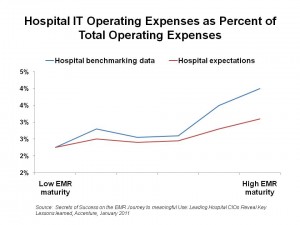 Mature users of electronic health records bear many scars and learnings, having been through the first several rungs of the health information technology (HIT) adoption ladder. A few of these lessons for HIT adoption success…
Mature users of electronic health records bear many scars and learnings, having been through the first several rungs of the health information technology (HIT) adoption ladder. A few of these lessons for HIT adoption success…
- Implementing EMRs is a strategic and not just an IT-department initiative. HIT adoption requires top-down commitment and engagement.
- It takes longer and costs more than the planners of systems expect.
- During transition to an EMR, hospitals see an 80% “spike” (increase) in IT operating expenses — directly impacting the hospital’s overall operating budget as much as 200 basis points or more. There is evidence that those spikes could be permanent over the longer term.
- Skilled talent for HIT is in a shortage situation. Accenture says, “The war for health IT talent is on.”
- To get to meaningful use, getting to a “culture for adoption” is key: 75% of hospital clinicians must consistently use advanced EMR components such as computerized physician order entry. Doing so gets to (1) employee engagement which leads to (2) change management in the organization.
Accenture uncovered these important lessons in a survey of 15 CIOs with leading health systems throughout the U.S., each considered advanced (i.e., more mature) EMR users. [For HIT wonks, according to HIMSS’ definition, these hospitals would have achieved HIMSS Stage 4 EMR functionality: that is all ancillaries installed including lab, radiology, and pharmacy; capable of health information exchange; computerized data repository; controlled medical vocabulary; clinical decision support; nurse/clinical documentation; and, PACS outside of radiology.]
The chart illustrates that hospital CIOs underestimate what health IT costs operating budgets as a percent of total hospital operating expenses — especially over time, as the institution achieves ‘high EMR maturity.’
Health Populi’s Hot Points: Hospitals’ profit margins are being squeezed by Medicare rate cuts and pricing pressures from commercial payers. Furthermore, hospital CFOs face mounting patient bad-debt, due to higher co-pays and costs that patients are having trouble paying in the recession whether uninsured or under-insured.
At the same time, the hospital CIOs note that HIT implementation costs in several ways: technology hardware and software are the easier-to-forecast hard costs in the equation. The more difficult and tougher cost-nut to crack is health IT staffing: how to attract and retain the skilled talent needed to make HIT implementation happen and keep it on-track to meet meaningful use requirements.
The pool of information technology talent is shallow; furthermore, health providers are competing for this talent with other vertical industries such as financial services, telecommunications, automotive, and pure tech companies. That supply/demand gap drives the price of HIT staff up, negatively impacting operating costs for providers who are already-cash-strapped.
To prevent hospital CFO sticker-shock, CIOs budget estimates should note a key lesson of their pioneering CIO brethren when it comes to HIT budgeting: the amount spent on support and maintenance labor increases by four times over the average implementation time frame.




 Thank you, Trey Rawles of @Optum, for including me on
Thank you, Trey Rawles of @Optum, for including me on  I was invited to be a Judge for the upcoming
I was invited to be a Judge for the upcoming  For the past 15 years,
For the past 15 years,